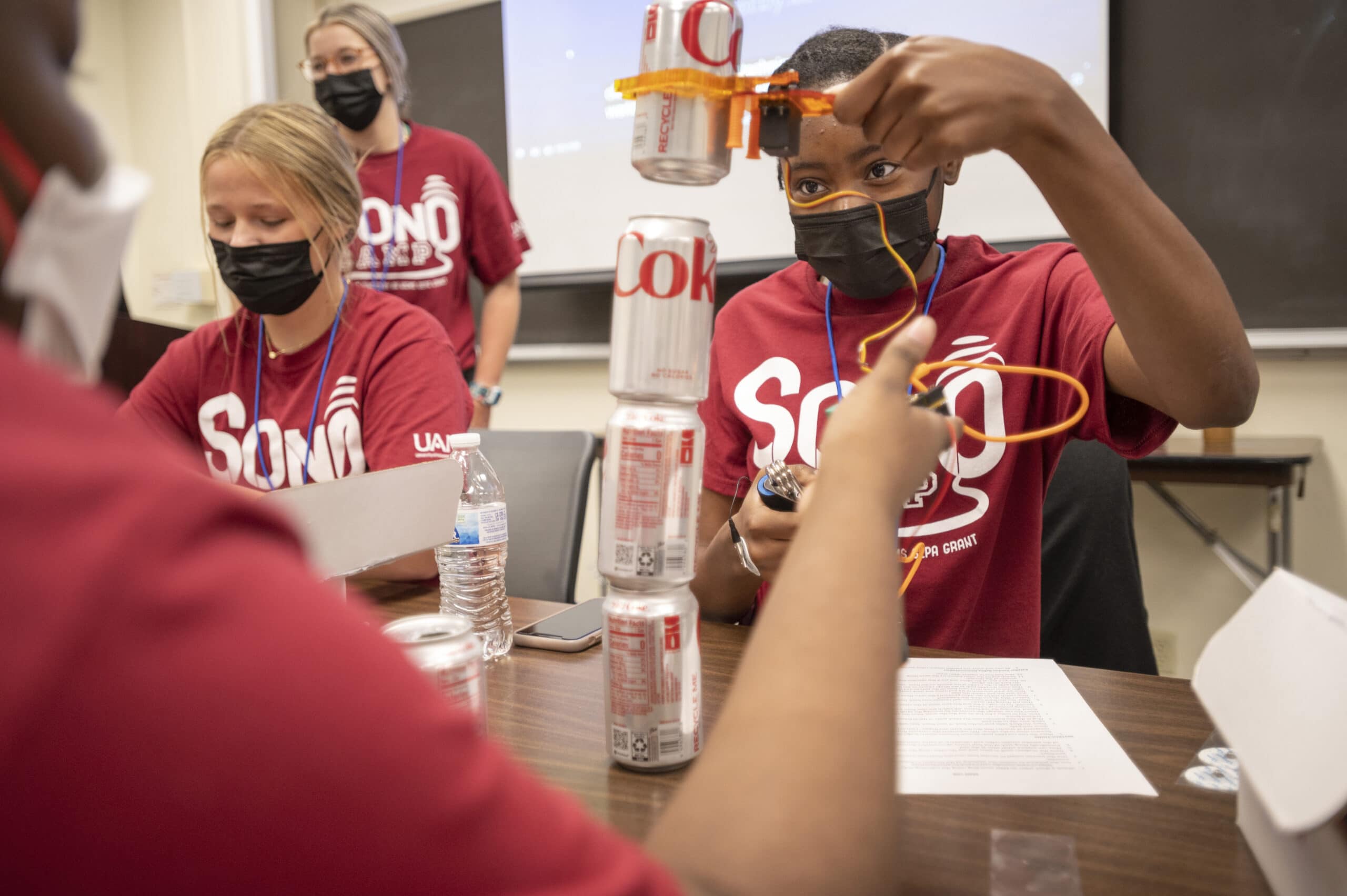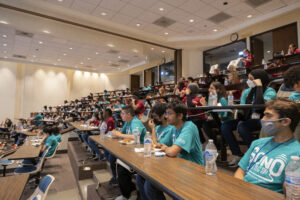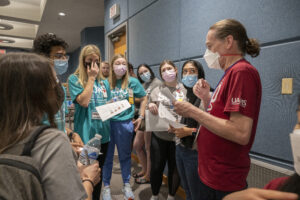View Larger Image

SONOcamp students learn about the mechanics behind EMG tests.
Image by Evan Lewis
UAMS SONOcamp 2022 Shows High School Students that “Science Can Be Fun”
| June 30, 2022 | As a standardized patient sat at a table and raised his right arm, the left side of an image of his brain lit up on a laptop screen.
It showed that the left side of your brain controls the right side of your body, a University of Arkansas for Medical Sciences (UAMS) medical student explained from the other side of the table to a handful of high school students who watched the live EEG recording of the man’s brain activity.
As the man alternately sat relatively still, moved slightly or talked, different parts of his brain flickered on and off in different colors on the laptop screen. Sometimes there was a flurry of activity on one side of the brain or another. The medical student told an onlooker that the brain activity the students were able to view on the laptop screen resulted from just 14 leads being connected to the patient’s skull, whereas in clinical EEG tests, doctors would use about 200 leads and see much more brain activity.
The high school students were among 60 rising sophomores, juniors or seniors at 19 Central Arkansas high schools who were at UAMS to attend SONOcamp 2022, a free weeklong summer camp from June 13-17. The camp, which started in 2019 but was canceled the past two summers in lieu of virtual programs because of pandemic concerns, is a way for students to learn about medicine and science, perhaps encouraging some in career possibilities they hadn’t considered before.
Across the hall, another group of high school students fastened surface electrodes onto their forearms and then squeezed a hand grip exerciser, prompting a mechanical claw hooked up to a motherboard a short distance away to open and close. The students used the claw to grab and stack empty soda cans on top of each other, in the process learning about the mechanics behind an EMG test, which measures muscle response or electrical activity in response to a nerve’s stimulation of the muscle.
“They’re monitoring the electrical activity in the muscle and converting it to mechanical energy,” explained Kevin D. Phelan, Ph.D., a professor in the UAMS College of Medicine Department of Neurobiology and Developmental Sciences who is program director of the ArkanSONO program, which includes the summer day camp.
In a corner of the room, Shayla McKissock, a rising second-year medical student, stood in a circle of high school students at a reflex station, where she demonstrated how to hit a hammer against the patellar tendon just below the knee cap to evoke quadriceps and hamstring muscle reactions.
“One relaxes and one contracts, and it kicks out,” she said, adding that this particular exercise did not involve the brain but was strictly a spinal-cord reflex.
“You can tell how fast the muscle takes to react,” she said. In response to the patient’s fraction of a second reaction, she said, “That’s a good reflex.”

Students watch and learn in a classroom setting before breaking into groups for hands-on experiences.Evan Lewis
Throughout the week, students worked in small and large groups on various guided activities that also included demonstrations of anatomy of major organ systems in the body (such as cardiovascular, renal, gastrointestinal and nervous systems) using real human cadaveric specimens, ultrasound imaging on standardized patients and analysis of 3D reconstructions of computerized tomography.
Guided by 13 UAMS medical students and faculty, they worked with standardized patients to collect data related to heart rate, blood pressure, pulse oximeter measurements and infrared imaging, as well as how to assess reflexes and cranial nerve functions.
For Yousef Abuabdou, 15, who will be a sophomore at Little Rock’s Central High School this fall, the summer camp program helped further his interest in a medical career while potentially clarifying or narrowing that path.
While initially thinking about a career in orthopaedics, he said that “after doing the CT scans, now I lean more toward radiology and things like that.”
Abuabdou said that before looking at the detailed diagnostic images of the inside of the body that were produced through a combination of X-rays and computer technology, he did some research on the arteries and the heart, making the CT scans especially meaningful.
Ethan Williams, also 15 and a rising sophomore at Bryant High School, said he signed up for the camp to help him “find out what I want to do” eventually as a career.
Asked about his most interesting experience at the camp, he said, “Yesterday, we had CPR training. We had to save a manikin who had a pulse like a real person. We could see the heart rate and everything you’d see in the ER, on a computer screen.”
Phelan said the students who attended the camp were self-selected, so they tended to be very enthusiastic about the learning experiences.
“They’re super smart, so this is a great group to be interacting with,” he said.
Phelan paused for a moment to look in on a newly assembled group just starting to learn about the EEGs and EKGs, which measured the electrical activity in the heart of a standardized patient who lay on a hospital bed.
“Hey guys, isn’t this cool?” he asked, receiving an immediate thunderous response from several students: “Yeah!”
Phelan, whose excitement about the program seemed to rival that of the high school students as he moved between the groups with a huge smile on his face, said, “We’re trying to be the spark that generates interest, or continuing interest, in science and medicine. We’re showing them that science can be fun, and you’re learning something at the same time. Students learn better when they’re doing something.”
The ArkanSONO project is funded by a five-year, $1.27 million education research grant that Phelan received in 2018. The Science Education Partnership Award (SEPA) is from the National Institutes of General Medicine Sciences (NIGMS), National Institutes of Health (NIH).
